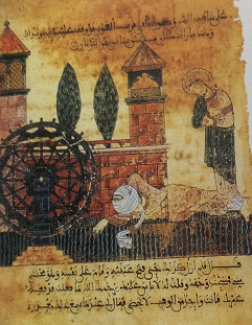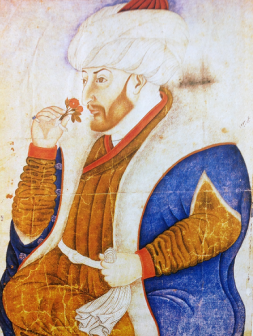Fatimid Egypt, Seljuk Persia, al-Andalus, the Ottoman Empire
Fatimid Egypt presided over such an artistic explosion as to eclipse the Abbasid capital's production. Social and religious circumstances stimulated this renewal in an already propitious environment. The Umayyad and Abbasid tradition in figurative art endured augmented by a specific Fatimid input. Indeed the populations' religious mix yielded the widest diversity introducing its share of representations of Christian figures, such as Jesus, along with some Jewish themes. Technically, naturalism generally prevailed.
In Seljuk ruled Persia, illuminations showed off the importance of local artistic trends flavoured with Manichaean and Chinese influences. It is at that time that haloes appeared over the head of some iconic figures, the Prophet of Islam first among them. After the Mongol invasion in the 13th century, the change was so radical that it is possible to speak of a re-birth of Persian miniature. Technically, images had no depth, no recession: no change of size intervened to indicate levels from foreground to background. The artist's imagination lent a fantastic, unreal feel to the compositions. As for the landscapes they owed more to the Chinese than to the Arab tradition. The same decorative themes were adopted in carpet weaving: figurative images of hunts or battles inserted among geometric or other patterns.
Al Andalus' Hispano-Muslim art unfolded over eight centuries. It offers a syncretism of Persian and Byzantine elements merged with local Roman and Visigothic components and suffused with Muslim references. Two features stand out: ornamental diversity and the decorative profusion of the gardens. Christian Ewert has itemised close on sixteen hundred patterns in the Medina Azahara's Salon Rico alone. F. Ruggles, who studied the significance of the gardens in the Hispano-Muslim context, asserts that the lush vegetation did not simply fulfil an ornamental or functional role; it was a metaphor for the Garden of Eden. Thus in the midst of this paradisiac environment, the eye may feast on fountains supported by animal statues, for instance in the Alhambra. The figural motives were more largely developed in workshops where craftsmen gave a free rein to their creativity. They created precious fabrics and luxury goods, usually adorned with two or three subjects, not least the human figure alongside animals such as lions, antelopes, peacocks. Illumination was also practiced in Almohad days. To wit the manuscript of the Hadith Bayad wa Riyad which retells the love story between a merchant and a maid.

 Informations[1]
Informations[1]
 Informations[2]
Informations[2]Ottoman art has this in common with Hispano-Muslim art that it partakes in both the Byzantine and European heritage. Portraiture flourished no sooner had the monarchs called on Italian painters to create them. The same monarchs further promoted the translation and reproduction of books whilst rejecting the press. Neither was the space where living beings may figure restricted to the pages of manuscripts and their illuminated illustrations, figurative art was practiced also on other materials such as fabrics and stucco. Many household goods and textiles boasted images of people or animals. The graphic decoration of pottery hints for its part at Chinese and Sassanid influences. It proposes heroic scenes, or floral, geometric, epigraphic patterns, and human and animal figures.

 Informations[3]
Informations[3]





